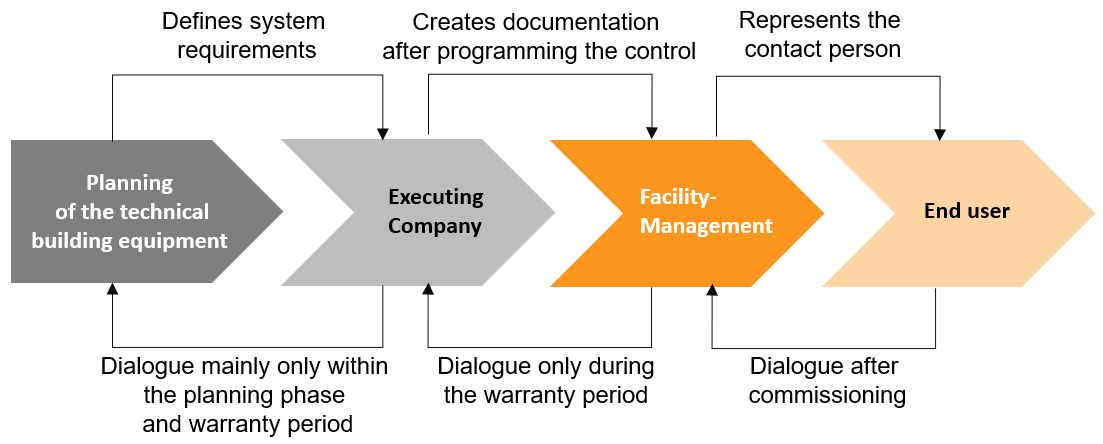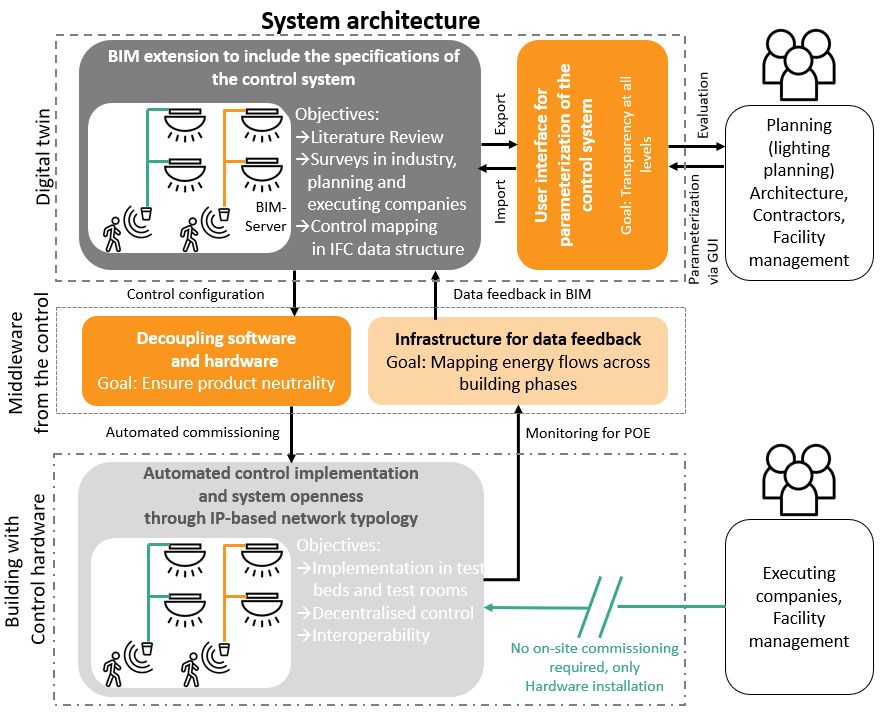TwinLight - BIM-based implementation of daylight and artificial lighting controls
Short Description
Status
ongoing
Starting point / motivation
Currently, the planning of IT-based control systems for non-residential buildings is carried out in the course of tenders, based on functionality requirements. Based on this catalog of requirements, the selection as well as the installation of the control system is done purely on site and mostly trade-specific. As a result, there is a lack of transparency with regard to higher planning levels and other parties involved in the construction process, making it difficult to assess the quality and system performance of the implemented building control system.
This problem is aggravated by the mostly missing post-occupancy evaluation. Furthermore, the manufacturer's choice of mostly centralized control hardware often results in limitations regarding interoperability with other systems, system extensibility, and variability, e.g., due to proprietary protocols. As a result, the on-site commissioning of such control logics, especially for complex target applications, can be time-consuming and thus costly, and can lead to quality deficits that ultimately result in poor energy efficiency or insufficient user comfort in the operation of the building.
Contents and goals
In recent years, digital building models based on Building Information Modeling (BIM) standards have been made usable for all phases of a building's life, with the goal of improving efficiency in all phases, as well as increasing user comfort and energy efficiency. For the daylighting and artificial lighting trades, as the first central trades, there are opportunities to significantly simplify on-site commissioning and to exploit new opportunities for maintenance, monitoring and improving building operation. The project goal of TwinLight is to develop a BIM-based Digital Twin that elevates the entire lifecycle for daylighting and artificial lighting to the BIM level.
Methods
The TwinLight framework will also include model-based control of lighting technology in buildings, thus supporting the coordination of lighting designers, facility managers and manufacturers in the planning, validation, configuration, optimization and maintenance of lighting technology systems. The logic of the control system will thus be elevated to a higher planning level, enabling new analyses and data-driven feedback loops, e.g., to increase energy efficiency and user quality in the building. As part of the project, the control software needs to be detached from proprietary systems, by designing a middleware built on a system-open, IP-based network topology.
The project will be carried out in an interdisciplinary way in the fields of building services engineering (esp. daylighting and artificial lighting), energy efficient building and computer science (model engineering). The developed concept will be tested with regard to applicability, system stability and functionality in test rooms as well as under real application. By including end users of all construction project phases in the conception and the evaluation, a high usability of the envisaged system architecture shall be created in order to make construction processes more efficient and to improve energy efficiency in the future.
Expected results
The goal is to create a BIM-based user tool for lighting control systems that ensures transparency between those responsible, enables ongoing system adjustments and automates the commissioning of control systems on site through the BIM2Control data transfer. Energy and process data are to be mapped across construction phases in the digital twin via information feedback from data from operation (Control2BIM). Advantages of integral concepts, potentials in the area of personalization and ICT-technologies are to be utilized via an open system architecture.
BILD Systemarchitektur
Project Partners
Project management
Zumtobel Lighting GmbH
Project or cooperation partners
- Hella Sun and Weather Protection Technology GmbH
- University of Innsbruck, Institute of Construction and Materials Science, Department of Energy Efficient Construction
- University of Innsbruck, Department of Computer Science
Contact Address
Zumtobel Lighting GmbH
Johannes Beiter
Schweizerstrasse 30
A-6850 Dornbirn
Tel.: +43 (664) 80892 3201
E-mail: johannes.beiter@zumtobelgroup.com
Web: https://www.zumtobel.com/com-de/index.html


